Numerical Simulation of Double Layered Wire Mesh Integration on the Cathode for a Proton Exchange Membrane Fuel Cell (PEMFC)
Abstract
1. Introduction
2. Method and Description
2.1. Boundary Conditions and Governing Equations
- The model is operated under steady-state conditions.
- The gas mixture is treated as ideal and incompressible.
- The flow within the fields resembles a mist, thereby precluding the presence of liquid water in the flow fields.
- Uniform and isotropic physical properties are assumed for both the catalyst layers and the membrane.
- The fuel cell is presumed to operate isothermally, with temperature evenly distributed.
- The crossover of gases in the PEM is not taken into consideration.
- The flow within the fuel cell is categorized as laminar due to its low velocity.
- The influence of gravitational force is considered negligible and therefore disregarded.
2.1.1. Momentum in the Porous Medium
2.1.2. Conservation of Mass Transport
2.1.3. Electrochemical Kinetics
2.2. Numerical Methods
3. Results and Discussion
3.1. Model Validation
3.2. Velocity Field
3.3. Pressure Distribution
3.4. Oxygen Distribution
3.5. Water Accumulation
3.6. Current Density
4. Conclusions
- The DLWM configuration demonstrated a slightly lower maximum velocity compared to the 3D fine mesh. The convective flow induced by the DLWM design facilitated the effective mixing of less concentrated fluid with fresh reactants, leading to a substantial reduction in concentration losses and promoting optimal cell performance.
- The DLWM exhibited a significantly reduced pressure drop, making it a viable option for balancing PEMFC cost and performance. This even distribution of gases significantly enhanced the efficiency and effectiveness of electrochemical reactions, contributing to optimal cell performance.
- The DLWM and the 3D fine mesh exhibited a marginal 1.06% difference in maximum oxygen distribution, emphasizing the importance of ensuring an even supply of oxygen and preventing water accumulation on the cathode side.
- While both the 3D fine mesh and the DLWM facilitated rapid water removal, the 3D fine mesh demonstrated quicker water removal compared to the DLWM. The instant water removal with the 3D mesh underscored its advantage over the DLWM, where water accumulation was observed over time.
- The investigation revealed that, at a voltage of 0.5 V, the local current density reached a peak of 2137.17 mA/cm2, highlighting the importance of maintaining a uniform current density distribution for efficient and stable PEMFC operation.
Author Contributions
Funding
Data Availability Statement
Acknowledgments
Conflicts of Interest
References
- Barbir, F. PEM Fuel Cells: Theory and Practice; Academic Press: Cambridge, MA, USA, 2012. [Google Scholar]
- Kim, B.; Lee, Y.; Woo, A.; Kim, Y. Effects of cathode channel size and operating conditions on the performance of air-blowing PEMFCs. Appl. Energy 2013, 111, 441–448. [Google Scholar] [CrossRef]
- Chen, H.; Liu, B.; Zhang, T.; Pei, P. Influencing sensitivities of critical operating parameters on PEMFC output performance and gas distribution quality under different electrical load conditions. Appl. Energy 2019, 255, 113849. [Google Scholar] [CrossRef]
- Kim, K.H.; Lim, J.W.; Kim, M. Development of carbon fabric/graphite hybrid bipolar plate for PEMFC. Compos. Struct. 2013, 98, 103–110. [Google Scholar] [CrossRef]
- Pan, Z.F.; An, L.; Zhao, T.S.; Tang, Z.K. Advances and challenges in alkaline anion exchange membrane fuel cells. Prog. Energy Combust. Sci. 2018, 66, 141–175. [Google Scholar] [CrossRef]
- Wang, Y.; Chen, K.S.; Mishler, J.; Cho, S.C.; Adroher, X.C. A review of polymer electrolyte membrane fuel cells: Technology, applications, and needs on fundamental research. Appl. Energy 2011, 88, 981–1007. [Google Scholar] [CrossRef]
- Yan, S.; Yang, M.; Sun, C.; Xu, S. Liquid water characteristics in the compressed gradient porosity gas diffusion layer of proton exchange membrane fuel cells using the Lattice Boltzmann Method. Energies 2023, 16, 6010. [Google Scholar] [CrossRef]
- Wang, Y.; Liu, T.; Sun, H.; He, W.; Fan, Y.; Wang, S. Investigation of dry ionomer volume fraction in cathode catalyst layer under different relative humilities and nonuniform ionomer-gradient distributions for PEM fuel cells. Electrochim. Acta 2020, 353, 136491. [Google Scholar] [CrossRef]
- Deng, S. Analytical Study of the Electroosmotic Flow of Two Immiscible Power-Law Fluids in a Microchannel. Open J. Fluid Dyn. 2022, 12, 263–276. [Google Scholar] [CrossRef]
- Wang, Z.H.; Wang, C.Y.; Chen, K.S. Two-phase flow and transport in the air cathode of proton exchange membrane fuel cells. J. Power Sources 2001, 94, 40–50. [Google Scholar] [CrossRef]
- Bao, Z.; Niu, Z.; Jiao, K. Analysis of single-and two-phase flow characteristics of the 3-D fine mesh flow field of proton exchange membrane fuel cells. J. Power Sources 2019, 438, 226995. [Google Scholar] [CrossRef]
- Nawale, S.M.; Dlamini, M.M.; Weng, F.B. Analyses of the Effects of Electrolyte and Electrode Thickness on High-Temperature Proton Exchange Membrane Fuel Cell (H-TPEMFC) Quality. Membranes 2022, 13, 12. [Google Scholar] [CrossRef] [PubMed]
- Yang, C.; Wan, Z.; Chen, X.; Kong, X.; Zhang, J.; Huang, T.; Wang, X. Geometry optimization of a novel M-like flow field in a proton exchange membrane fuel cell. Energy Convers. Manag. 2021, 228, 113651. [Google Scholar] [CrossRef]
- Wang, C.T.; Hu, Y.C.; Zheng, P.L. Novel biometric flow slab design for improvement of PEMFC performance. Appl. Energy 2010, 87, 1366–1375. [Google Scholar] [CrossRef]
- Li, X.; Sabir, I. Review of bipolar plates in PEM fuel cells: Flow-field designs. Int. J. Hydrogen Energy 2005, 30, 359–371. [Google Scholar] [CrossRef]
- Kim, A.R.; Shin, S.; Um, S. Multidisciplinary approaches to metallic bipolar plate design with bypass flow fields through deformable gas diffusion media of polymer electrolyte fuel cells. Energy 2016, 106, 378–389. [Google Scholar] [CrossRef]
- Shi, Z.; Wang, X. A numerical study of flow crossover between adjacent flow channels in a proton exchange membrane fuel cell with serpentine flow field. J. Power Sources 2008, 185, 985–992. [Google Scholar] [CrossRef]
- Zehtabiyan-Rezaie, N.; Arefian, A.; Kermani, M.J.; Noughabi, A.K.; Abdollahzadeh, M. Effect of flow field with converging and diverging channels on proton exchange membrane fuel cell performance. Energy Convers. Manag. 2017, 152, 31–44. [Google Scholar] [CrossRef]
- Chen, H.; Guo, H.; Ye, F.; Ma, C.F. A numerical study of baffle height and location effects on mass transfer of proton exchange membrane fuel cells with orientated-type flow channels. Int. J. Hydrogen Energy 2021, 46, 7528–7545. [Google Scholar] [CrossRef]
- Ghanbarian, A.; Kermani, M.J.; Scholta, J.; Abdollahzadeh, M. Polymer electrolyte membrane fuel cell flow field design criteria–application to parallel serpentine flow patterns. Energy Convers. Manag. 2018, 166, 281–296. [Google Scholar] [CrossRef]
- Li, Y.; Zhou, Z.; Liu, X.; Wu, W.T. Modeling of PEM fuel cell with thin MEA under low humidity operating conditions. Appl. Energy 2019, 242, 1513–1527. [Google Scholar] [CrossRef]
- Wang, X.D.; Yan, W.M.; Duan, Y.Y.; Weng, F.B.; Jung, G.B.; Lee, C.Y. Numerical study on channel size effect for proton exchange membrane fuel cell with serpentine flow field. Energy Convers. Manag. 2010, 51, 959–968. [Google Scholar] [CrossRef]
- Kim, B.; Cha, D.; Kim, Y. The effects of air stoichiometry and air excess ratio on the transient response of a PEMFC under load change conditions. Appl. Energy 2015, 138, 143–149. [Google Scholar] [CrossRef]
- Hwang, J.J.; Dlamini, M.M.; Weng, F.B.; Chang, T.; Lin, C.H.; Weng, S.C. Simulation of fine mesh implementation on the cathode for proton exchange membrane fuel cell (PEMFC). Energy 2022, 244, 122714. [Google Scholar] [CrossRef]
- Abdulla, S.; Patnaikuni, V.S. Enhanced cross-flow split serpentine flow field design for square cross-sectional polymer electrolyte membrane fuel cell. Electrochim. Acta 2021, 391, 138884. [Google Scholar] [CrossRef]
- Ferng, Y.M.; Su, A. A three-dimensional full-cell CFD model was used to investigate the effects of different flow channel designs on PEMFC performance. Int. J. Hydrogen Energy 2007, 32, 4466–4476. [Google Scholar] [CrossRef]
- Baz, F.B.; Ookawara, S.; Ahmed, M. Enhancing under-rib mass transport in proton exchange membrane fuel cells using new serpentine flow field designs. Int. J. Hydrogen Energy 2019, 44, 30644–30662. [Google Scholar] [CrossRef]
- Choi, K.S.; Kim, H.M.; Moon, S.M. Numerical studies on the geometrical characterization of serpentine flow-field for efficient PEMFC. Int. J. Hydrogen Energy 2011, 36, 1613–1627. [Google Scholar] [CrossRef]
- Chiu, H.C.; Jang, J.H.; Yan, W.M.; Li, H.Y.; Liao, C.C. A three-dimensional modeling of transport phenomena of proton exchange membrane fuel cells with various flow fields. Appl. Energy 2012, 96, 359–370. [Google Scholar] [CrossRef]
- Jang, J.Y.; Cheng, C.H.; Liao, W.T.; Huang, Y.X.; Tsai, Y.C. Experimental and numerical study of proton exchange membrane fuel cell with spiral flow channels. Appl. Energy 2012, 99, 67–79. [Google Scholar] [CrossRef]
- Spernjak, D.; Prasad, A.K.; Advani, S.G. In situ comparison of water content and dynamics in parallel, single-serpentine, and interdigitated flow fields of polymer electrolyte membrane fuel cells. J. Power Sources 2010, 195, 3553–3568. [Google Scholar] [CrossRef]
- Jeon, D.H.; Greenway, S.; Shimpalee, S.; Van Zee, J.W. The effect of serpentine flow-field designs on PEM fuel cell performance. Int. J. Hydrogen Energy 2008, 33, 1052–1066. [Google Scholar] [CrossRef]
- Konno, N.; Mizuno, S.; Nakaji, H.; Ishikawa, Y. Development of compact and high-performance fuel cell stack. SAE Int. J. Altern. Powertrains 2015, 4, 123–129. [Google Scholar] [CrossRef]
- Nonobe, Y. Development of the fuel cell vehicle mirai. IEEJ Trans. Electr. Electron. Eng. 2017, 12, 5–9. [Google Scholar] [CrossRef]
- Yoshida, T.; Kojima, K. Toyota MIRAI fuel cell vehicle and progress toward a future hydrogen society. Electrochem. Soc. Interface 2015, 24, 45. [Google Scholar] [CrossRef]
- Weng, F.B.; Dlamini, M.M.; Hwang, J.J. Evaluation of flow field design effects on proton exchange membrane fuel cell performance. Int. J. Hydrogen Energy 2023, 48, 14866–14884. [Google Scholar] [CrossRef]
- Zhang, G.; Bao, Z.; Xie, B.; Wang, Y.; Jiao, K. Three-dimensional multi-phase simulation of PEM fuel cell considering the full morphology of metal foam flow field. Int. J. Hydrogen Energy 2021, 46, 2978–2989. [Google Scholar] [CrossRef]
- Li, S.; Sundén, B. Three-dimensional modeling and investigation of high temperature proton exchange membrane fuel cells with metal foams as flow distributor. Int. J. Hydrogen Energy 2017, 42, 27323–27333. [Google Scholar] [CrossRef]
- Atyabi, S.A.; Afshari, E.; Zohravi, E.; Udemu, C.M. Three-dimensional simulation of different flow fields of proton exchange membrane fuel cell using a multi-phase coupled model with cooling channel. Energy 2021, 234, 121247. [Google Scholar] [CrossRef]
- Hwang, J.J.; Chao, C.H. Species-electrochemical transports in a free-breathing cathode of a PCB-based fuel cell. Electrochim. Acta 2007, 52, 1942–1950. [Google Scholar] [CrossRef]
- Hwang, J.J.; Chen, C.O.K.; Savinell, R.F.; Liu, C.C.; Wainright, J. A three-dimensional numerical simulation of the transport phenomena in the cathodic side of a PEMFC. J. Appl. Electrochem. 2004, 34, 217–224. [Google Scholar] [CrossRef]
- Shi, Z.; Wang, X. Comparison of Darcy’s law, the Brinkman equation, the modified NS equation and the pure diffusion equation in PEM fuel cell modeling. In Proceedings of the COMSOL Conference, Boston, MA, USA, 4–6 October 2007. [Google Scholar]
- Pan, C.; Li, D.; Liang, K.; Meng, X.; Pan, M. Theoretical analysis on cold start process of proton exchange membrane fuel cell with different flow fields based on the coupling of redox reaction and dynamic response of porous materials. Energy Convers. Manag. 2022, 253, 115128. [Google Scholar] [CrossRef]
- Song, J.; Guo, H.; Ye, F.; Ma, C.F. Mass transfer and cell performance of a unitized regenerative fuel cell with nonuniform depth channel in oxygen-side flow field. Int. J. Energy Res. 2019, 43, 2940–2962. [Google Scholar] [CrossRef]
- Park, D.; Ham, S.; Sohn, Y.J.; Choi, Y.Y.; Kim, M. Mass transfer characteristics according to flow field and gas diffusion layer of a PEMFC metallic bipolar plate for stationary applications. Int. J. Hydrogen Energy 2023, 48, 304–317. [Google Scholar] [CrossRef]
- Comsol Multiphysics. Fuel Cell & Electrolyzer Module User’s Guide Ver, 5.6; Comsol Multiphysics: Burlington, MA, USA, 2020. [Google Scholar]
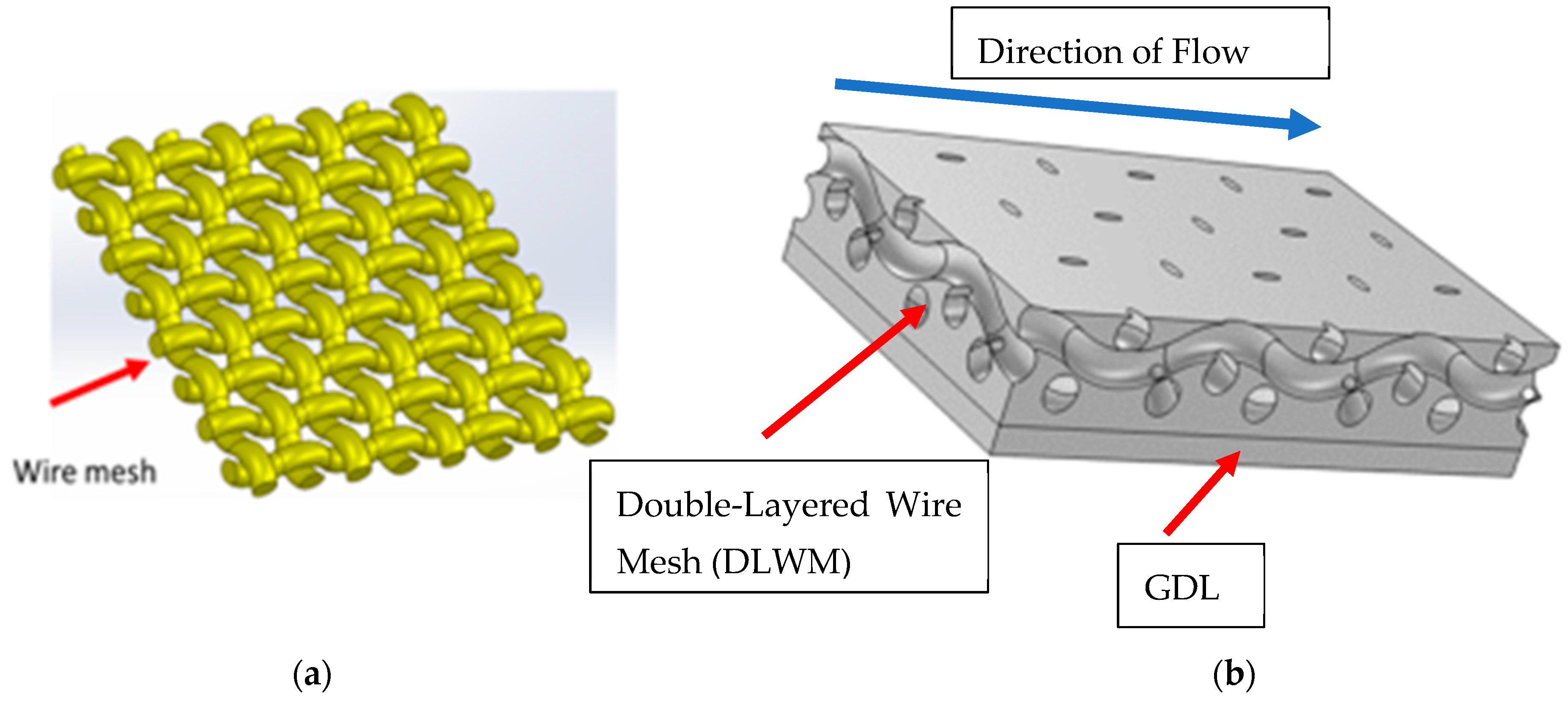
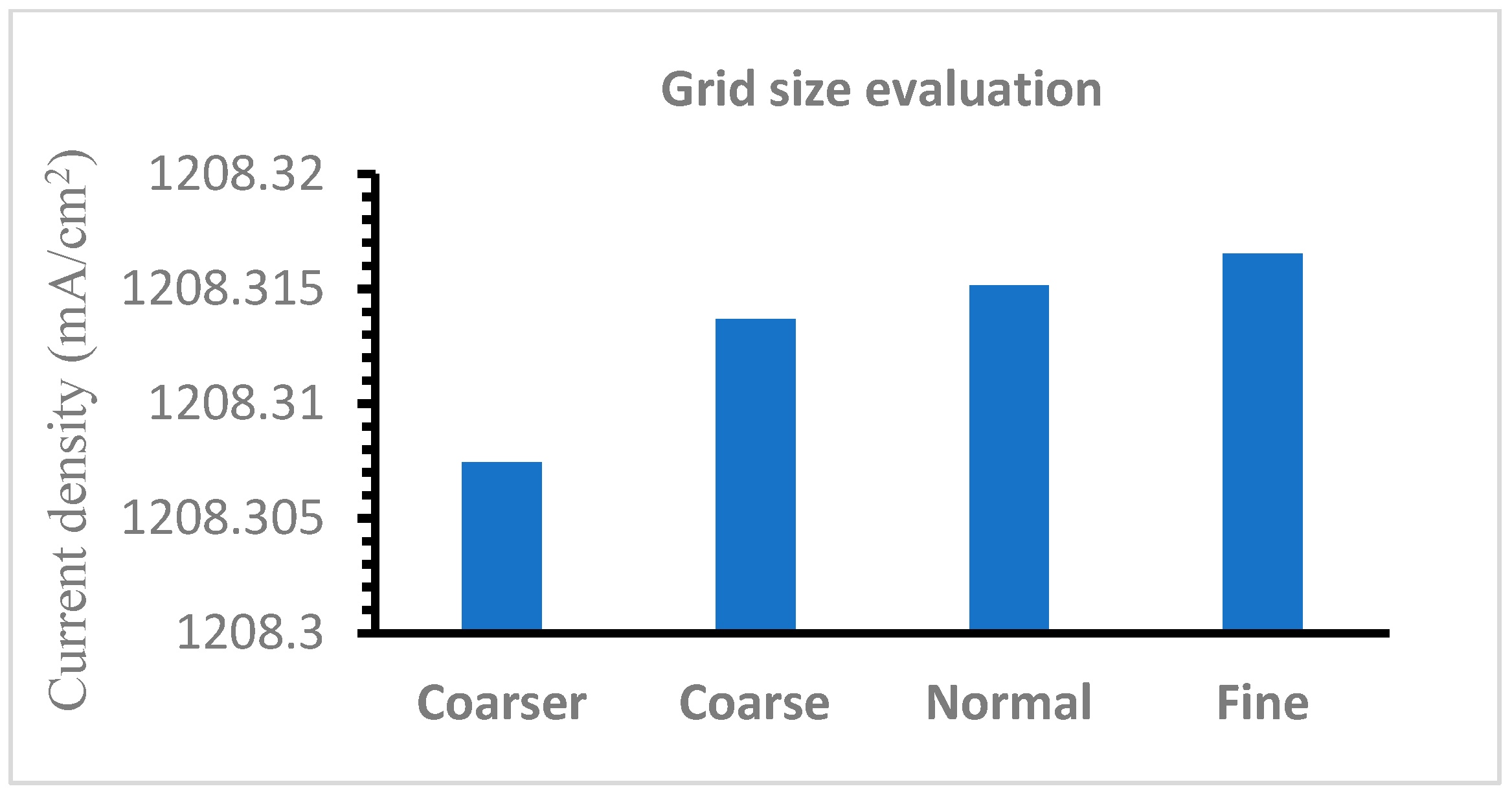
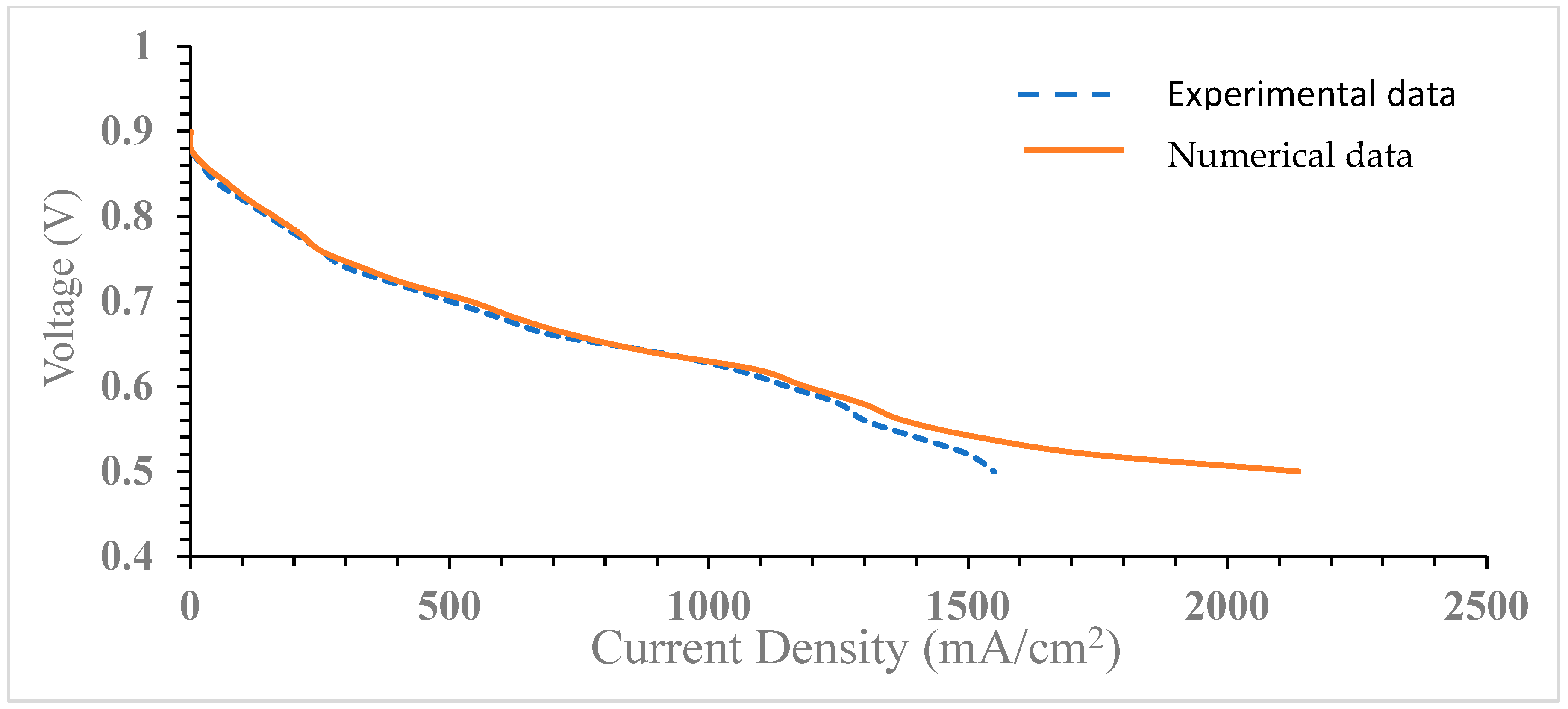
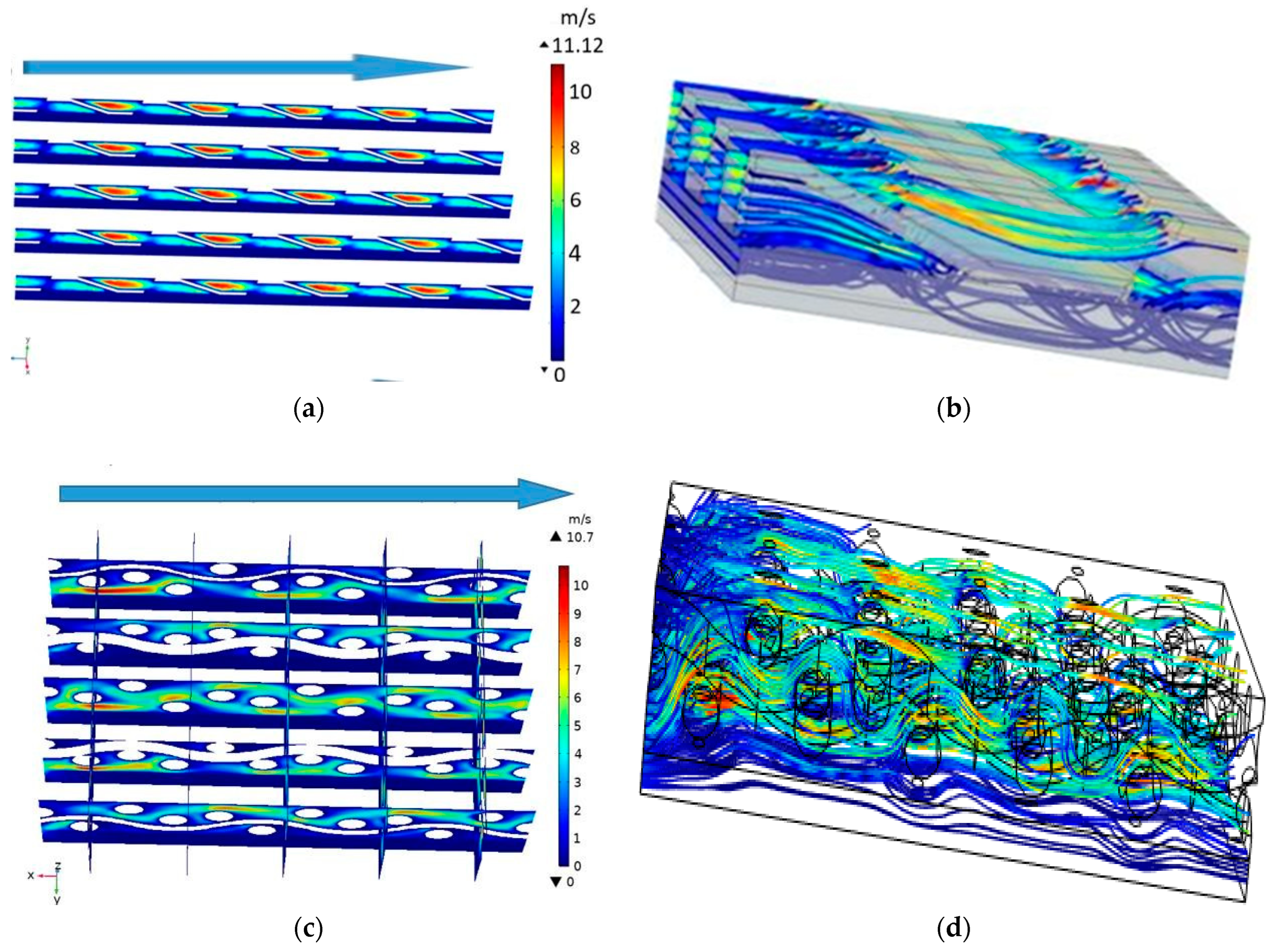
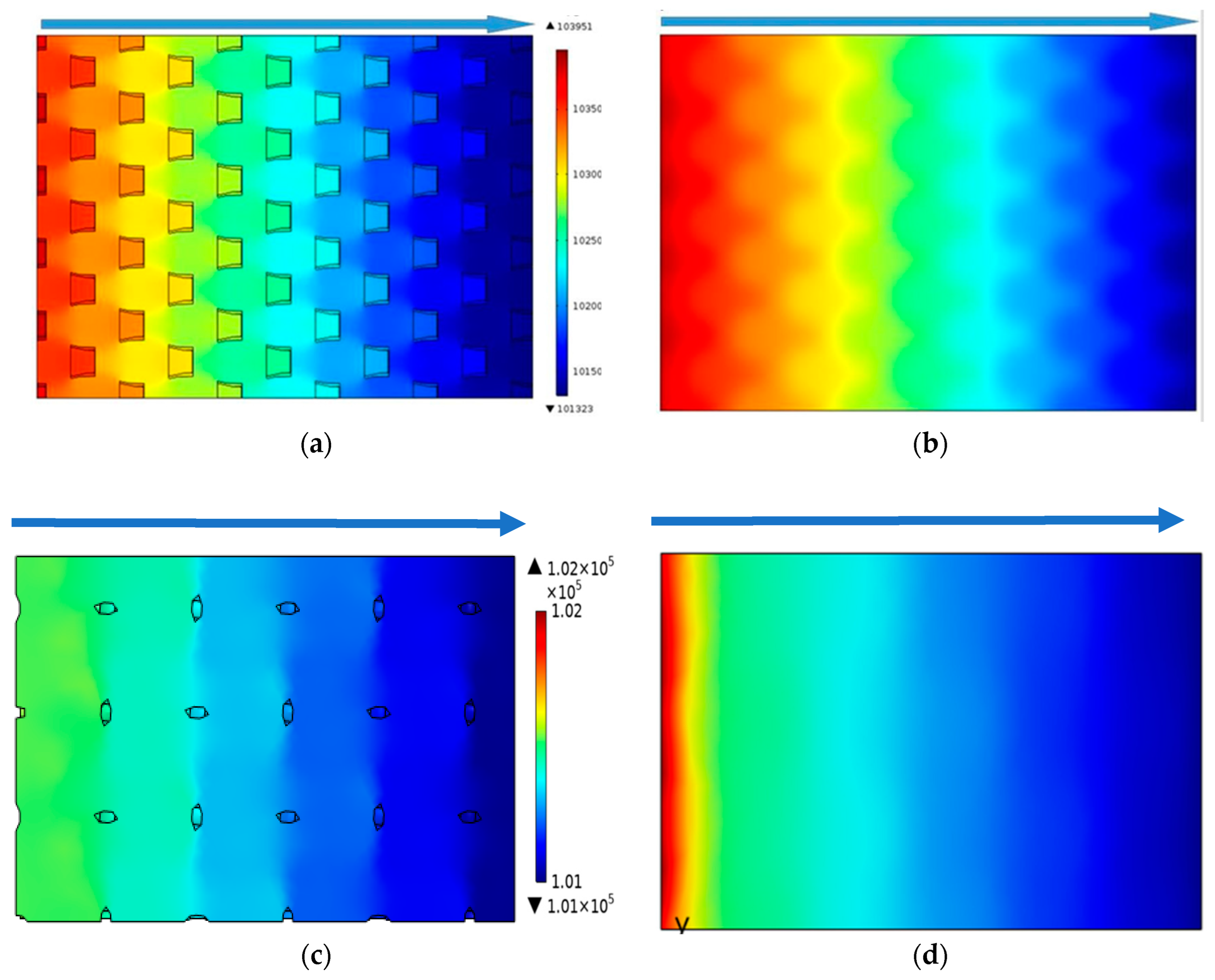
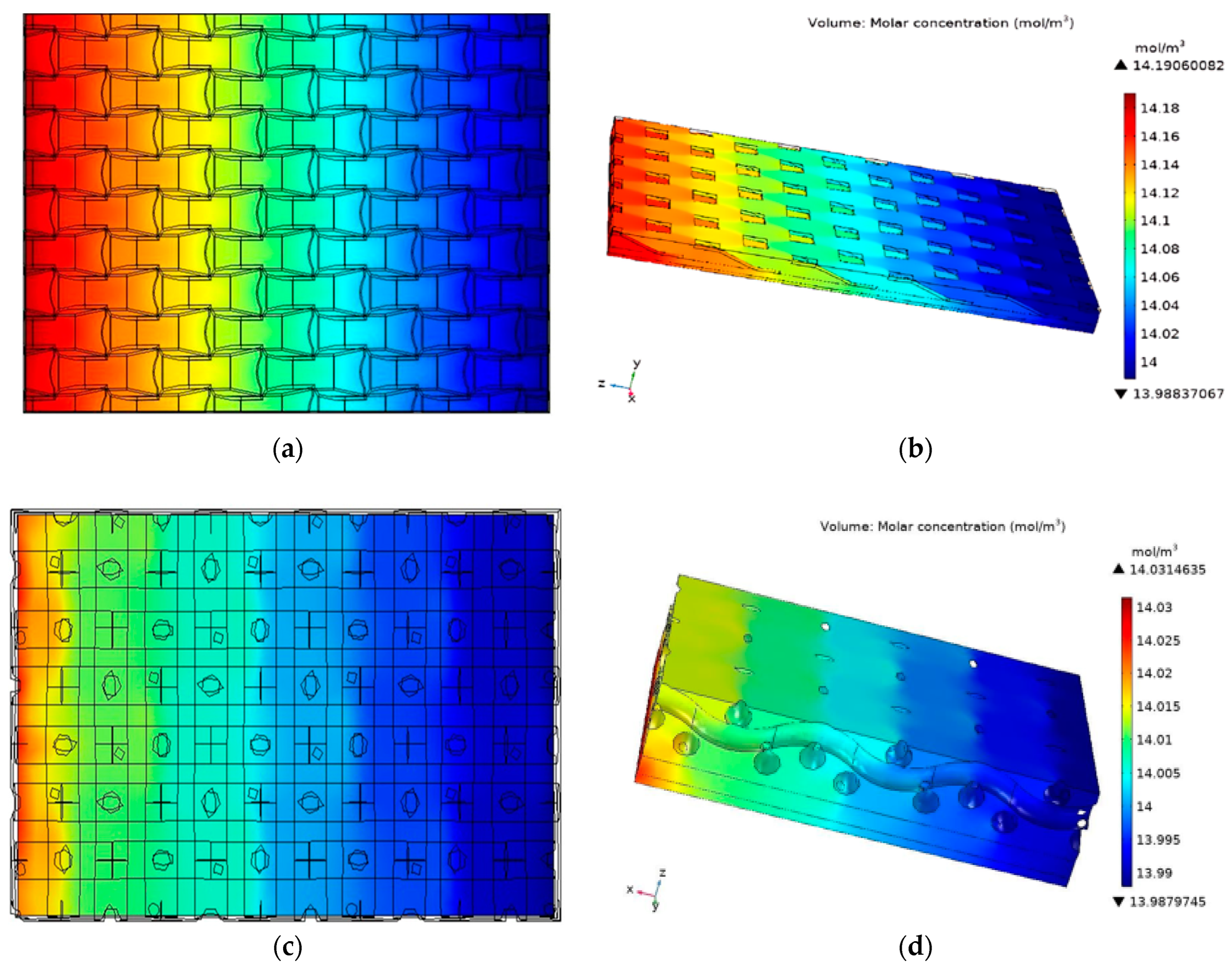

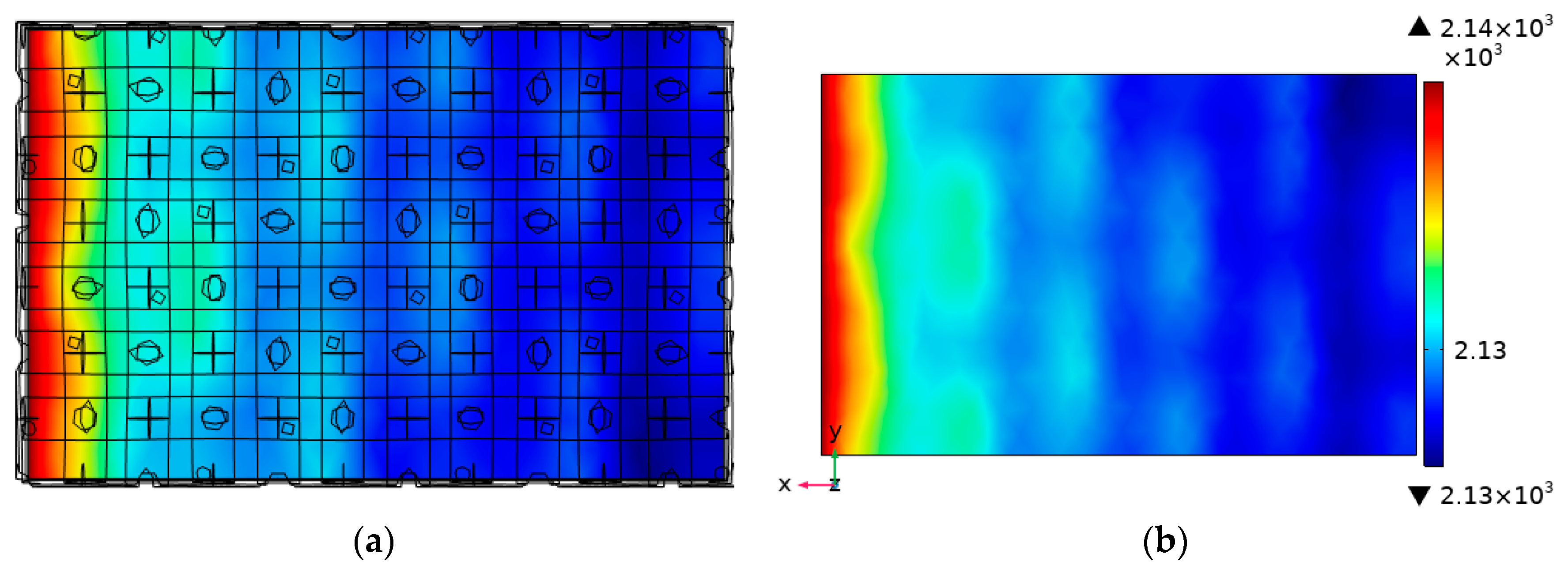
| Description | Units | Value |
|---|---|---|
| Rib width | m | 7 × 10−4 |
| Channel width | m | 0.002 |
| Plate width | m | 0.05 |
| Double-layered wire mesh thickness | m | 0.002 |
| Gas diffusion layer thickness | m | 0.0055 |
| Channel-to-channel distance | m | 0.0027 |
| Inner radius of channel corners | m | 2.5 × 10−4 |
| Description | Units | Value |
|---|---|---|
| Cell Voltage | V | 0.5 |
| Open circuit voltage | V | 0.95 |
| Lumped anode + membrane resistance | Ω·m2 | 2.85 × 10−5 |
| Temperature of the cell | K | 353.15 |
| Reference oxygen concentration | mol/m3 | 40.88 |
| Porosity of the GDL | % | 40 |
| Permeability of the GDL | m2 | 1.18 10−11 |
| Initial water mass fraction (cathode) | - | 0.023 [24] |
| Initial oxygen mass fraction (cathode) | - | 0.228 [24] |
| Initial velocity | m/s | 2 [24] |
| Fluid viscosity | Pa·s | 2.46 × 10−5 |
| The molar mass of Nitrogen | kg/mol | 0.028 [24] |
| The molar mass of Water | kg/mol | 0.018 [24] |
| Oxygen molar mass | kg/mol | 0.032 [24] |
| Diffusion coefficient of the N2-H2O binary system. | m2/s | 3.2682 × 10−5 |
| Diffusion coefficient of the O2-N2 binary system. | m2/s | 3.0466 × 10−5 |
| Diffusion coefficient of the O2-H2O binary system. | m2/s | 3.5807 × 10−5 |
| Reference pressure | Pa | 1.01 × 105 |
| Cathodic transfer coefficient | - | 0.73761 |
Disclaimer/Publisher’s Note: The statements, opinions and data contained in all publications are solely those of the individual author(s) and contributor(s) and not of MDPI and/or the editor(s). MDPI and/or the editor(s) disclaim responsibility for any injury to people or property resulting from any ideas, methods, instructions or products referred to in the content. |
© 2024 by the authors. Licensee MDPI, Basel, Switzerland. This article is an open access article distributed under the terms and conditions of the Creative Commons Attribution (CC BY) license (https://creativecommons.org/licenses/by/4.0/).
Share and Cite
Tirumalasetti, P.R.; Weng, F.-B.; Dlamini, M.M.; Chen, C.-H. Numerical Simulation of Double Layered Wire Mesh Integration on the Cathode for a Proton Exchange Membrane Fuel Cell (PEMFC). Energies 2024, 17, 278. https://doi.org/10.3390/en17020278
Tirumalasetti PR, Weng F-B, Dlamini MM, Chen C-H. Numerical Simulation of Double Layered Wire Mesh Integration on the Cathode for a Proton Exchange Membrane Fuel Cell (PEMFC). Energies. 2024; 17(2):278. https://doi.org/10.3390/en17020278
Chicago/Turabian StyleTirumalasetti, Pandu Ranga, Fang-Bor Weng, Mangaliso Menzi Dlamini, and Chia-Hung Chen. 2024. "Numerical Simulation of Double Layered Wire Mesh Integration on the Cathode for a Proton Exchange Membrane Fuel Cell (PEMFC)" Energies 17, no. 2: 278. https://doi.org/10.3390/en17020278
APA StyleTirumalasetti, P. R., Weng, F.-B., Dlamini, M. M., & Chen, C.-H. (2024). Numerical Simulation of Double Layered Wire Mesh Integration on the Cathode for a Proton Exchange Membrane Fuel Cell (PEMFC). Energies, 17(2), 278. https://doi.org/10.3390/en17020278







